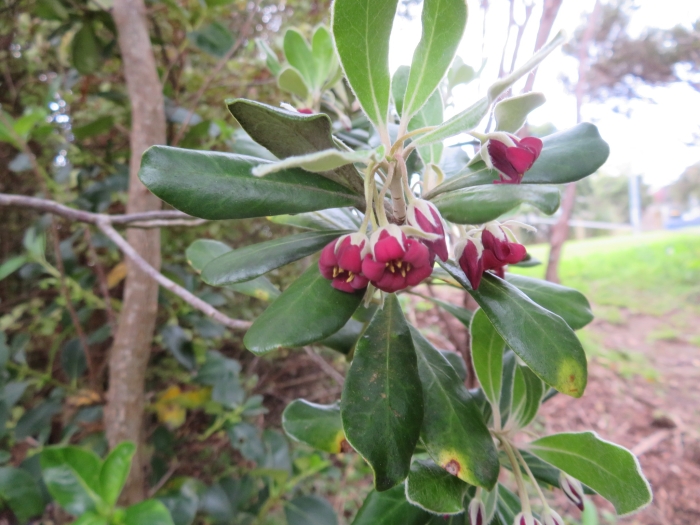Karo
(Pittosporum crassifolium)
Karo (Pittosporum crassifolium)
/
/

Jenny Christianson
CC BY 4.0
Image By:
Jenny Christianson
Recorded By:
Copyright:
CC BY 4.0
Copyright Notice:
Photo by: Jenny Christianson | License Type: CC BY 4.0 | License URL: http://creativecommons.org/licenses/by/4.0/ | Rights Holder: Jenny Christianson | Publisher: iNaturalist | Date Created: 2019-09-14T12:29:48-07:00 |




















































Estimated Native Range
Summary
Pittosporum crassifolium, commonly known as Karo, is an evergreen shrub or small tree native to coastal and lowland forests in New Zealand. It typically grows to about 5 meters (16 ft) in height and has a dense, rounded form. The leaves are dark gray-green, leathery, and have a furry texture underneath, which helps the plant conserve moisture in its native windy coastal habitat. In spring, Karo produces clusters of small, red-purple flowers that are subtly fragrant, followed by seed pods that split open to reveal sticky seeds. The flowers are not particularly showy but add a modest ornamental value.
Karo is valued for its hardiness and the textural quality of its foliage, making it a suitable choice for hedges, screens, and coastal gardens where wind tolerance is necessary. It is also used in urban environments due to its ability to withstand pollution. Karo prefers full sun but can tolerate part shade, and while it is drought-tolerant once established, it performs best with regular watering in well-drained soils. It is relatively low-maintenance but can be affected by scale insects and sooty mold. Gardeners should be aware that the seeds can be messy and that the plant may self-seed if not properly managed.CC BY-SA 4.0
Karo is valued for its hardiness and the textural quality of its foliage, making it a suitable choice for hedges, screens, and coastal gardens where wind tolerance is necessary. It is also used in urban environments due to its ability to withstand pollution. Karo prefers full sun but can tolerate part shade, and while it is drought-tolerant once established, it performs best with regular watering in well-drained soils. It is relatively low-maintenance but can be affected by scale insects and sooty mold. Gardeners should be aware that the seeds can be messy and that the plant may self-seed if not properly managed.CC BY-SA 4.0
Plant Description
- Plant Type: Tree, Shrub
- Height: 15-30 feet
- Width: 6-15 feet
- Growth Rate: Rapid
- Flower Color: Purple
- Flowering Season: Summer
- Leaf Retention: Evergreen
Growth Requirements
- Sun: Full Sun
- Water: Medium
- Drainage: Slow, Medium
Common Uses
Bee Garden, Border Plant, Erosion Control, Fragrant, Hedges, Low Maintenance, Salt Tolerant, Street Planting
Natural Habitat
Coastal and lowland forests in New Zealand
Other Names
Common Names: Stiffleaf Cheesewood, Kaikaro, Kīhihi
Scientific Names: , Pittosporum crassifolium, Pittosporum crassifolium var. strictum,
GBIF Accepted Name: Pittosporum crassifolium Banks & Sol. ex A.Cunn.